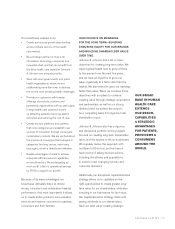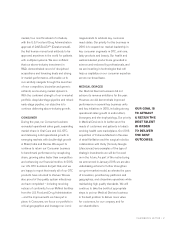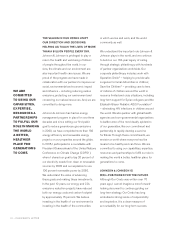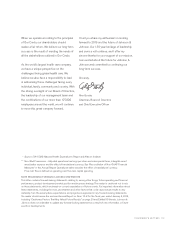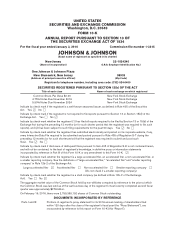Johnson and Johnson 2015 Annual Report Download - page 15
Download and view the complete annual report
Please find page 15 of the 2015 Johnson and Johnson annual report below. You can navigate through the pages in the report by either clicking on the pages listed below, or by using the keyword search tool below to find specific information within the annual report.of the Company’s largest product, REMICADE®(infliximab), accounted for approximately 9.4% of the Company’s total
revenues for fiscal 2015. Accordingly, the patents related to this product are believed to be material to the Company.
There are two sets of patents related specifically to REMICADE®(infliximab). The first set of patents is co-owned by
Janssen Biotech, Inc., a wholly-owned subsidiary of Johnson & Johnson, and NYU Langone Medical Center (NYU).
Janssen Biotech, Inc. has an exclusive license to NYU’s interests in the patents. These patents have expired in all countries
outside the United States. In the United States, the latest of these patents expires in September 2018 and this patent
stands rejected and is subject to reexamination proceedings instituted by a third party in the United States Patent and
Trademark Office. Those proceedings are on going.
The second set of patents specifically related to REMICADE®was granted to The Kennedy Institute of Rheumatology in
Europe, Canada, Australia and the United States. Janssen Biotech, Inc. has licenses (exclusive for human anti-TNF
antibodies and semi-exclusive for non-human anti-TNF antibodies) to these patents that expire in 2017 outside of the
United States and 2018 in the United States. The validity of these patents has been challenged. Certain claims have been
invalidated and others are under review in various patent offices around the world and are also subject to litigation in
Canada.
The Company does not expect that any additional extensions will be available for the above described patents specifically
related to REMICADE®. If any of the REMICADE®related patents discussed above is found to be invalid, any such patent
could not be relied upon to prevent the introduction of biosimilar versions of REMICADE®. For a more extensive
description of legal matters regarding the patents related to REMICADE®, see Note 21 “Legal Proceedings – Intellectual
Property – Pharmaceutical – REMICADE®Related Cases” of the Notes to Consolidated Financial Statements included in
Item 8 of this Report.
In addition to competing in the immunology market with REMICADE®, the Company is currently marketing STELARA®
(ustekinumab), SIMPONI®(golimumab) and SIMPONI ARIA®(golimumab), next generation immunology products with
remaining patent lives of up to eight years.
Trademarks
The Company’s subsidiaries have made a practice of selling their products under trademarks and of obtaining protection
for these trademarks by all available means. These trademarks are protected by registration in the United States and other
countries where such products are marketed. The Company considers these trademarks in the aggregate to be of material
importance in the operation of its businesses.
Seasonality
Worldwide sales do not reflect any significant degree of seasonality; however, spending has been heavier in the fourth
quarter of each year than in other quarters. This reflects increased spending decisions, principally for advertising and
research and development activity.
Competition
In all of their product lines, the Company’s subsidiaries compete with companies both locally and globally. Competition
exists in all product lines without regard to the number and size of the competing companies involved. Competition in
research, both internally and externally sourced, involving the development and the improvement of new and existing
products and processes, is particularly significant. The development of new and innovative products, as well as protecting
the underlying intellectual property of the Company’s product portfolio, is important to the Company’s success in all areas
of its business. The competitive environment requires substantial investments in continuing research. In addition, the
development and maintenance of customer demand for the Company’s consumer products involve significant
expenditures for advertising and promotion.
Research and Development
Research activities represent a significant part of the Company’s businesses. Research and development expenditures
relate to the processes of discovering, testing and developing new products, improving existing products, as well as
demonstrating product efficacy and regulatory compliance prior to launch. The Company remains committed to investing
in research and development with the aim of delivering high quality and innovative products. Worldwide costs of research
and development activities amounted to $9.0 billion, $8.5 billion and $8.2 billion for fiscal years 2015, 2014 and 2013,
respectively. Research facilities are located in the United States, Belgium, Brazil, Canada, China, France, Germany, India,
Israel, Japan, the Netherlands, Singapore, Switzerland and the United Kingdom.
Johnson & Johnson 2015 Annual Report •3


